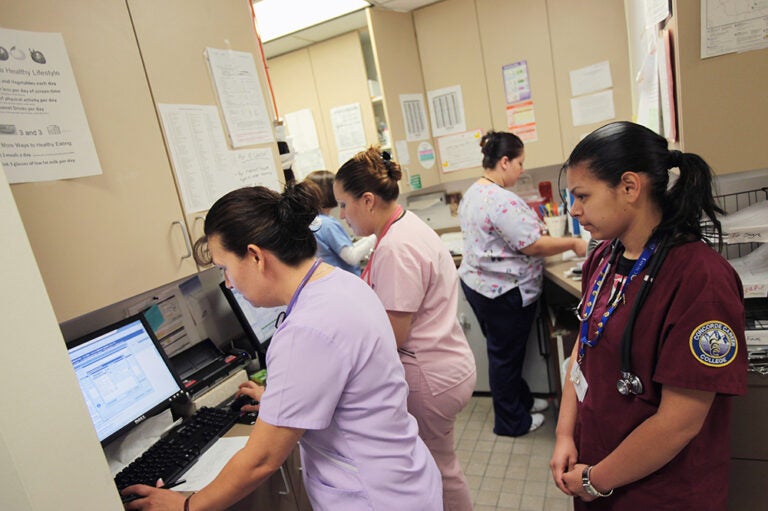In 2023, 26 million people — or 8 percent of the population — were uninsured, according to a report in September 2024 from the Census Bureau. While those numbers represent a significant portion of the population, the uninsured rate in 2023 remained at one of its lowest levels in history. Here’s a summary of the latest data to offer insights on how Americans currently get their coverage, how coverage differs across demographic and age lines, how the figures have changed over time, and how key federal programs like Medicare and Medicaid factor in.
How Has the Uninsured Rate Changed Over Time?
In the decade before the enactment of the Affordable Care Act (ACA) in 2010, the uninsured rate averaged 15 percent. In 2014, provisions of the ACA went into effect that enabled states to expand Medicaid eligibility and establish health insurance marketplaces. While outcomes varied by state, those policy changes contributed to a 3-percentage-point decrease in the share of uninsured people nationally in the initial year. As additional states adopted Medicaid expansion in the mid-2010s, the uninsured rate continued to drop, falling below 10 percent and remaining there since.
The share of Americans without health insurance remained relatively low throughout the COVID-19 pandemic as well. In fact, Census data show more people were insured in 2023 than before the pandemic — the number of insured Americans rose by 9 million from 2018, the last year of the report before the COVID-19 pandemic impacted data collection, to 2023. That increase was partially due to policies implemented during the pandemic to mitigate its impact, which increased enrollment in public health insurance programs, as well as changes in the labor force. The increased reliance on public health insurance stemmed from the fact many people became eligible for Medicaid and CHIP due to lay-offs and provisions in the Families First Coronavirus Response Act that required states to ensure continuous enrollment. In fact, enrollment in Medicaid and CHIP grew by 30 percent from February 2020 to December 2022, reflecting its counter-cyclical design.
Looking at 2023, Census data show that the uninsured rate of 8.0 percent was not statistically different than the uninsured rate of 7.9 percent in 2022. However, the continuous enrollment provision expired on March 31, 2023 and many states were disenrolling beneficiaries from Medicaid through July 2023. Because the Census report is based on data collected February through April each year, this year’s report does not capture the full extent of the unwinding of Medicaid’s continuous enrollment provision.
Public and Private Health Insurance
Health insurance is provided through various sources in both the private and public sectors. The Census Bureau defines the programs in each sector:
- Private Insurance includes employment-based insurance plans and plans purchased directly from a marketplace. It also includes TRICARE, which serves members of the military.
- Public Insurance includes Medicare, Medicaid, the Children’s Health Insurance Program (CHIP), and veterans’ health programs.
In 2023, private insurance programs covered nearly twice as many Americans as public programs. Of those with health insurance in 2023, nearly two-thirds were enrolled in a private program and around one-third in a public program. Coverage estimates are not mutually exclusive because people can be covered by more than one type of health insurance during the year.
Employment-based plans accounted for more than half of the population with insurance; the next largest sources of coverage were Medicaid and Medicare. Fifty-four percent of the population was covered by employer-sponsored insurance in 2023, which is a decrease of 0.8 percentage points from 2022. That is roughly the same share of the population covered by an employer compared to 2018 before the pandemic. Meanwhile, 19 percent of the population was enrolled in Medicare in 2023, up 0.2 percentage points from 2022 and a full percentage point from 2018. Those changes were partly the result of growth in the number of people age 65 and over.
Uninsured rates differ across states and largely depend on whether a state expanded Medicaid eligibility as part of the ACA. Both Medicaid and CHIP provide health insurance coverage for vulnerable populations, including children, and the expansion of Medicaid eligibility under the ACA led to a decrease in the uninsured rate for many states. As of 2023, a total of 41 states and jurisdictions expanded Medicaid eligibility — the average uninsured rate for children in states that expanded eligibility was 4.6 percent, while states that did not expand Medicaid had an average uninsured rate of 8.3 percent. Similarly, a higher proportion of working-age adults were uninsured in states that did not expand Medicaid.
Health Coverage by Age
Every year since the enactment of the ACA, the uninsured rate has been lower for all age groups than it was before its implementation. The uninsured rate for Americans age 65 and older slightly decreased by 0.2 percentage points between 2022 and 2023, but it remains the lowest of any age group as 93.8 percent of such individuals were covered by Medicare in 2023.
In the same time period, the uninsured rate for working-age adults — those between ages 19 and 64 — remained relatively the same at 10.9 percent. The overall uninsured rate for working-age adults is lower than other age groups because of higher costs. According to a KFF analysis, 64 percent of uninsured working-age adults in 2022 cited high costs as the reason why they lacked coverage. In states that have not expanded Medicaid eligibility, many working-age adults fall into a “coverage gap,” earning too much to qualify for Medicaid, but not enough to qualify for premium tax credits that make purchasing private insurance in the marketplaces affordable.
For children under the age of 19, the uninsured rate increased from 5.4 percent in 2022 to 5.8 percent in 2023. The higher uninsured rate is a result of the fact that there was a decrease of 730,000 children who were covered by employment-based plans and 105,000 fewer children covered by Medicare in 2023 compared to 2022. Though the uninsured rate increased, it is similar to the uninsured rate of 5.5 percent in 2018 before the pandemic. Changes in enrollment may reflect changes in the economy, changes in policy, and the temporary impact from provisions from COVID-19-related legislation. From the start of the pandemic in February 2020 to December 2022, enrollment in Medicaid increased by 32.6 percent and CHIP enrollment by 3.1 percent.
Health Coverage by Race
Heading into the pandemic, non-white Americans had the highest rates of being uninsured. This still holds true in the data from the pandemic, as those are also the groups that have been the most heavily affected by COVID-19 in regard to employment and health. In 2023, 38.7 percent of the population were people of color, but they accounted for 60.4 percent of the uninsured population.
Looking Forward
Though the number has improved significantly over the past decade, 26 million Americans remain uninsured. Looking ahead, policymakers should continue to work toward policies to improve the efficiency of the U.S. healthcare system, making it more accessible and affordable. Total healthcare spending in the United States is projected to account for nearly one-fifth of the economy by 2031. The federal share of that total is large and growing, which underscores the need to identify and implement solutions to improve healthcare performance in the United States, address a key driver of the federal debt, and better equip individuals to cope with serious threats to public health.
Image credit: John Moore/Getty Images
Further Reading
Budget Basics: Unemployment Insurance Explained
The Unemployment Insurance program is a key counter-cyclical tool to help stabilize the economy and speed recovery during downturns or crises.
Quiz: How Much Do You Know About Healthcare in the United States?
The United States has one of the largest and most complex healthcare systems in the world. Take our healthcare quiz to see how much you know about the cost and quality of the U.S. healthcare system.
How Did the One Big Beautiful Bill Act Change Healthcare Policy?
The OBBBA adds significantly to the nation’s debt, but its healthcare provisions lessen that impact by $1.0 trillion.


